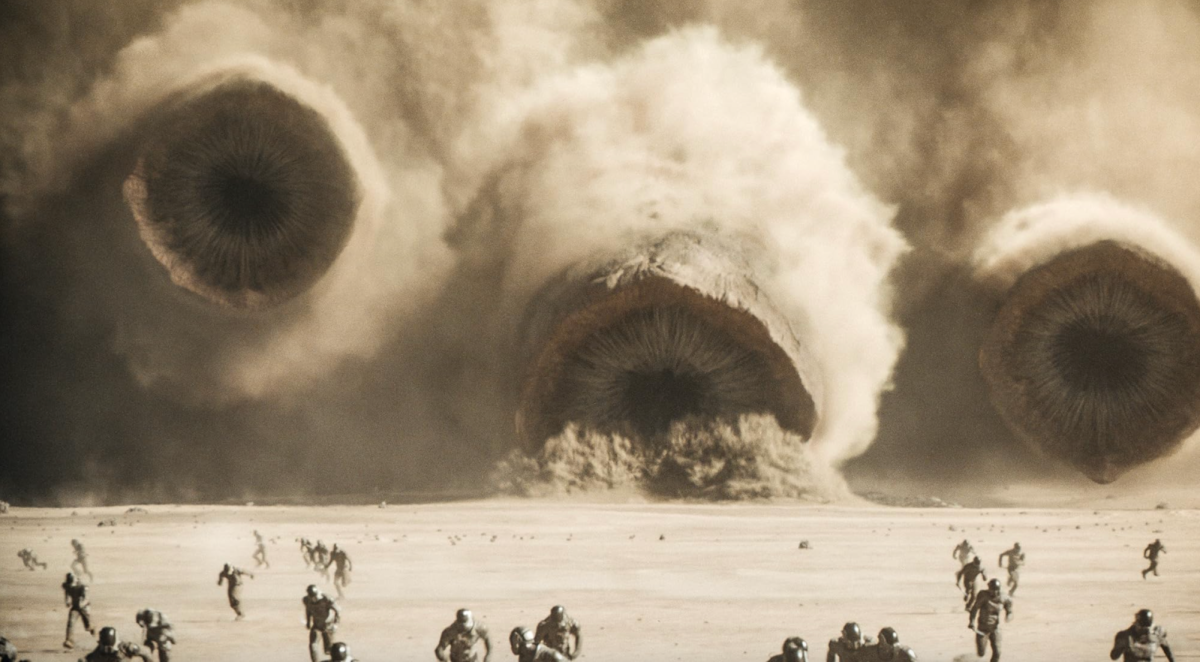No matter who you are (unless you’ve quite literally been living under a rock, in which case I’m glad you’re seeing this), you’ve heard the buzz about ‘‘Dune: Part 2” which was released on the first of March and directed by the critically acclaimed Denis Villeneuve. The continuation of the seemingly disappointing ‘‘Dune’’ (released in 2021) would turn all the heads toward it as the reviews came rolling in, praising it as the greatest sci-fi movie of the past century. Whether you were seeing it to appreciate Villeneuve’s latest release, have a good time with friends, or obtain the salacious popcorn bucket, you must see the film if you are to fully appreciate the train of popularity it has right now, as no other film this year will be as deserving of it as this one is.
‘‘Dune: Part 2’’ picks up right after the events of the first have unfolded, making a viewing of the first film essential if planning on viewing this. The worldbuilding many complained about culminated to create the context that is fundamental to the effectiveness of the impactful moments within this film. House Atreides has fallen to House Harkonnen under the command of Vladimir Harkonnen, but Paul Atreides has survived amongst the Fremen, the desert dwellers of half of Arrakis (akin to the Tusken Raiders of Star Wars). As Paul learns to live amongst the Fremen, his premonitions shape a cloudy future for the peace of the galaxy as the struggle for spice continues, leaving Paul to decide whether or not he wants to take the mantle of ‘‘Mahdi’’ (‘‘the one who will lead us to paradise’’) and lead the Fremen (and the spiritual continuation of House Atreides) to victory.
This film is packed with notable faces (Christopher Walken, Florence Pugh, Zendaya, Timothée Chalamet, Austin Butler, Josh Brolin, Dave Bautista, the list goes on) but it doesn’t even remove an ounce of immersion that this masterful piece of science fiction grants the viewer as they are greeted with the chants of the prophetic Mahdi before the film’s production companies even appear. The vast desert of Arrakis is truly captured in this film, giving a sense of vast territory that no other film has granted its landscape (not even the beautiful radiancy of Terra in ‘‘Blade Runner’’ can match it). This only leaves you with the desire to come back to Arrakis after the film has ended, beautifully capturing why the art of worldbuilding is so essential to creating immersive film. The scale of the sandworms deserves its notation, as the scale of their presence is alluring. Villeneuve has been known for scale in many of his films (‘‘Arrival’’ most notably), but the way the sandworms aren’t scary as much as they are intimidating is only something able to be captured because of the mix of the notion of preset natural wildlife donation and enhancements of size and scale. Although these worms are brainless, they are of enormous power. This is why the rite of riding one is so impactful, especially for an outsider like Paul Atreides.
The film is a cinematographer’s dream. Every shot is imbued with purpose, whether it be the stylistic purpose, moving the plot forward, or setting the scene for the next conflict/storyblock to take place. Along with purpose, they are visually stunning shots. The empty desert of Arrakis makes one truly feel as though they need to drink more water. The industrial sectors of the conquered Arrakis along with House Harkonnen’s home planet of Giedi Prime fuel the hollowness that all the Harkonnen soldiers emanate as they mindlessly slaughter the Fremen they can catch. In the gladiatorial arena where Feyd-Rautha (the Baron’s nephew) fights three Atreides soldiers is pale, immediately removing the hope of any victory of these soldiers in the face of the Harkonnens. Shots bleed of inspiration from films that came before it (the helicopter attack scene of “Apocalypse Now”, the spaceship of “Arrival”, the streets of “Blade Runner”, the settings of “Star Wars”, and so forth), giving a full-circle impact to the film as the original story was reused and used as inspiration for more sci-fi movies than Lord of the Rings was used for stories in the fantasy genre.
This film has something for everyone. If you want an enthralling sci-fi epic with prophecies and premonitions, watch this film. If you want a complex study on class systems and interminglings based on machiavellian intrigue, watch this film. If you want a deeply romantic film built on the heels of sacrifice and power, watch this film. I can’t emphasize enough that the conclusion of all of these statements is to simply watch this film. Religion, spirituality, politics, dogmas, classism, racism, militarism, and ecology all are wrapped in the neat package of power that serves as the main theme for the franchise of ‘‘Dune’’, and it is not better displayed on-screen than in this film (sorry David Lynch). This film gives hope for the future of cinema, as it proves what a grand budget can grant a film if used correctly. Hollywood blockbusters have been overrun by indie film directors with more creative and compelling stories in mind, but this proves that not only are adaptations capable of amazing things in modern film, but there are still directors who are willing to experiment and change the landscape of cinema if given the time, money, and backing to do so (including Scorsese, Nolan, and Lanthimos). If you were to take one thing away from this series of rambling paragraphs, it would be that you need to watch the film ‘‘by any means necessary’’ (and yes, Malcolm X would agree with the usage of this quote for such a dire concern).



![Jann Wenner [center] seen laughing with Paul McCartney [left] and Ringo Starr [right]](https://amityvilleecho.com/wp-content/uploads/2023/10/Rolling.jpg)



